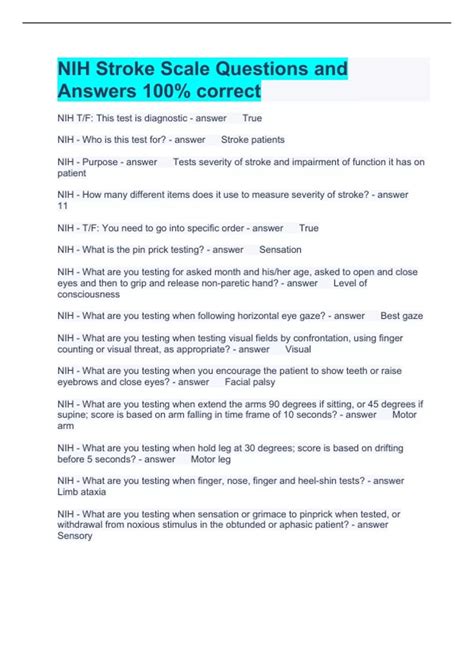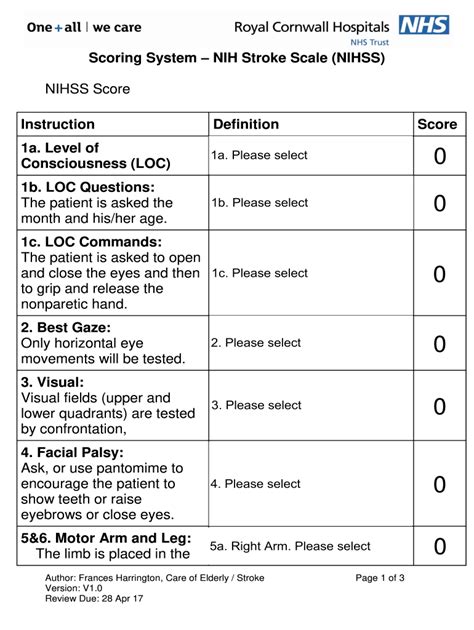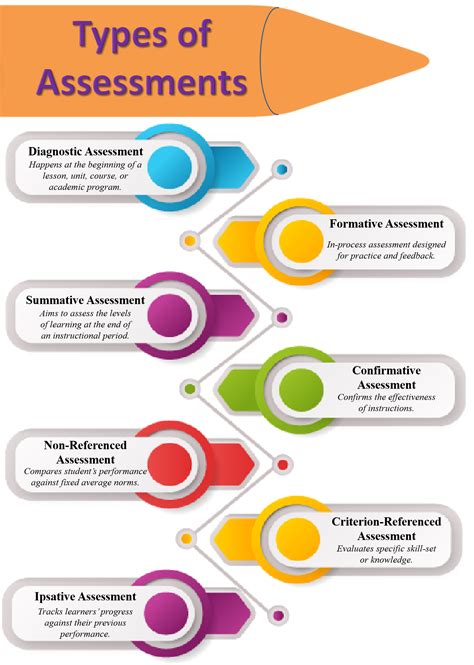Unlocking NIH Stroke Scale: Key Questions Explored

Explore the significance of NIH Stroke Scale questions in stroke assessment. Gain insights to enhance clinical proficiency and understand neurological evaluations.
In the realm of healthcare, NIH Stroke Scale (NIHSS) questions play a crucial role in assessing and quantifying the severity of stroke symptoms. Understanding these questions and their significance can be paramount in both clinical settings and research endeavors. This article aims to delve into the intricacies of the NIH Stroke Scale, elucidating its purpose, structure, and clinical implications. From elucidating the fundamental concepts to exploring practical applications, this discussion will equip readers with a comprehensive understanding of NIHSS and its relevance in the context of stroke assessment and management. Whether you're a healthcare professional seeking to enhance your proficiency in stroke evaluation or an individual keen on grasping the nuances of neurological assessments, this article endeavors to provide valuable insights into the realm of NIH Stroke Scale questions.
Top 10 Points about NIH Stroke Scale questions :
- Introduction to the NIH Stroke Scale
- Understanding the Purpose of NIHSS Questions
- Key Components of the NIH Stroke Scale
- Scoring and Interpretation Guidelines
- Role of NIHSS Questions in Stroke Assessment
- Importance of Standardized Assessment Tools
- Training and Certification for NIHSS Administration
- NIHSS Questions: Assessing Neurological Deficits
- Clinical Applications in Stroke Management
- Future Directions and Research Implications
Several facts about NIH Stroke Scale questions

Introduction to NIH Stroke Scale Questions
NIH Stroke Scale (NIHSS) questions are an essential component of stroke assessment, aiding healthcare professionals in evaluating the severity of neurological deficits in stroke patients. Developed by the National Institutes of Health, this standardized tool encompasses a series of questions and tasks designed to assess various aspects of neurological function.

Understanding the Purpose of NIHSS Questions
The primary purpose of NIHSS questions is to provide a quantitative measure of stroke severity, guiding treatment decisions and prognostic assessments. By systematically evaluating neurological deficits, healthcare providers can determine the appropriate course of action for each patient, optimizing outcomes and minimizing complications.

Key Components of the NIH Stroke Scale
The NIH Stroke Scale comprises various components, each targeting specific neurological functions such as consciousness, language, motor skills, and sensory perception. By assessing these domains, clinicians can identify the presence and severity of stroke-related impairments, aiding in diagnosis and treatment planning.

Scoring and Interpretation Guidelines
Scoring the NIHSS involves assigning points based on the patient's performance on each component, with higher scores indicating more severe deficits. Interpretation of these scores allows healthcare professionals to gauge the extent of neurological impairment and monitor changes over time, facilitating ongoing management and rehabilitation efforts.

Role of NIHSS Questions in Stroke Assessment
NIHSS questions play a crucial role in the comprehensive assessment of stroke patients, guiding the selection of appropriate interventions and monitoring response to treatment. By systematically evaluating neurological deficits, healthcare providers can tailor care plans to address specific needs and optimize patient outcomes.

Importance of Standardized Assessment Tools
The use of standardized assessment tools like the NIH Stroke Scale promotes consistency and accuracy in stroke evaluation, enabling healthcare providers to make informed decisions based on objective data. Standardization also facilitates communication among multidisciplinary teams and enhances the quality of care delivered to stroke patients.

Training and Certification for NIHSS Administration
Proficiency in administering the NIHSS requires specialized training and certification to ensure accurate and reliable assessment of stroke patients. Healthcare professionals undergo rigorous instruction on scoring criteria and administration techniques, ensuring consistency and validity in the use of this standardized tool.

NIHSS Questions: Assessing Neurological Deficits
Each NIHSS question targets specific aspects of neurological function, allowing healthcare providers to identify and quantify deficits in areas such as consciousness, language, motor skills, and sensory perception. By systematically evaluating these domains, clinicians can tailor interventions to address individual patient needs and facilitate recovery.

Clinical Applications in Stroke Management
The utilization of NIHSS questions in clinical practice extends beyond initial assessment to encompass ongoing monitoring and management of stroke patients. By tracking changes in neurological status over time, healthcare providers can adjust treatment strategies and rehabilitation plans to optimize outcomes and promote recovery.

Future Directions and Research Implications
As advancements in stroke care continue to evolve, ongoing research into the efficacy and validity of NIHSS questions remains paramount. By exploring new assessment techniques and refining existing protocols, researchers can enhance the accuracy and utility of this standardized tool, ultimately improving outcomes for stroke patients.
Sources: National Institute of Neurological Disorders and Stroke. (https://www.ninds.nih.gov/Disorders/Patient-Caregiver-Education/Hope-Through-Research/Stroke-Hope-Through-Research)
NIH Stroke Scale questions in Professional's eye
The
NIH Stroke Scale (NIHSS) questions stand as a cornerstone in the realm of healthcare, particularly in the assessment and management of stroke patients. Developed by the National Institutes of Health, this standardized tool serves as a pivotal instrument in evaluating the severity of neurological deficits following a stroke event.
Stroke, a leading cause of long-term disability and mortality globally, necessitates prompt and accurate assessment to guide treatment decisions and optimize patient outcomes. The utilization of standardized assessment tools such as the
NIHSS underscores the importance of objective and consistent evaluation in healthcare practice. Through a systematic approach encompassing various domains of neurological function,
NIHSS questions enable healthcare professionals to quantify the extent of impairment and tailor interventions accordingly. Transitioning seamlessly from consciousness to motor function assessments, the
NIH Stroke Scale provides a comprehensive framework for clinicians to evaluate and monitor stroke patients effectively. Embedding these assessments into routine clinical practice not only enhances the quality of care but also facilitates communication among multidisciplinary teams, fostering a collaborative approach to stroke management. In addition to its clinical utility, the
NIHSS plays a pivotal role in research endeavors aimed at advancing stroke care and improving patient outcomes. By standardizing assessment protocols and facilitating data collection, this tool contributes to the generation of evidence-based practices and informs ongoing research into stroke prevention, treatment, and rehabilitation strategies. As healthcare continues to evolve, the
NIH Stroke Scale questions remain indispensable in guiding clinical decision-making, promoting consistency in stroke assessment, and ultimately enhancing the quality of care delivered to stroke patients worldwide.
Point of Views : NIH Stroke Scale questions
The
NIH Stroke Scale (NIHSS) questions serve as a critical component in the assessment of stroke patients, providing healthcare professionals with a standardized method to evaluate neurological deficits.Developed by the National Institutes of Health, the
NIHSS encompasses a series of questions and tasks designed to assess various aspects of neurological function, including consciousness, language, motor skills, and sensory perception.These questions enable clinicians to quantify the severity of impairment following a stroke event, guiding treatment decisions and prognostic assessments.By systematically evaluating neurological deficits, healthcare providers can tailor interventions to address specific patient needs and optimize outcomes.The utilization of standardized assessment tools like the
NIH Stroke Scale promotes consistency and accuracy in stroke evaluation, facilitating communication among multidisciplinary teams and enhancing the quality of care delivered to stroke patients.In addition to its clinical utility, the
NIHSS plays a crucial role in research endeavors aimed at advancing stroke care and improving patient outcomes.Standardizing assessment protocols and facilitating data collection, this tool contributes to the generation of evidence-based practices and informs ongoing research into stroke prevention, treatment, and rehabilitation strategies.As healthcare continues to evolve, the
NIH Stroke Scale questions remain indispensable in guiding clinical decision-making, promoting consistency in stroke assessment, and ultimately enhancing the quality of care provided to stroke patients worldwide.
Conclusion :As we conclude our exploration of NIH Stroke Scale (NIHSS) questions, we trust that you have gained valuable insights into their significance in stroke assessment and management. The NIHSS serves as a vital tool for healthcare professionals, providing a standardized approach to evaluate neurological deficits in stroke patients. Through systematic assessment of various domains such as consciousness, language, motor skills, and sensory perception, clinicians can accurately quantify the severity of impairment and tailor interventions accordingly.
Furthermore, the utilization of standardized assessment tools like the NIH Stroke Scale promotes consistency and accuracy in stroke evaluation, enhancing communication among multidisciplinary teams and ultimately improving the quality of care delivered to stroke patients. Whether you're a healthcare professional seeking to enhance your proficiency in stroke assessment or an individual interested in understanding the nuances of neurological evaluations, we hope this exploration has provided valuable insights into the realm of NIHSS questions and their relevance in healthcare practice.
Questions and Answer for NIH Stroke Scale questions
Curious minds often ponder various questions about NIH Stroke Scale (NIHSS) questions. Here are some of the most common queries:
- What is the purpose of NIHSS questions?
The purpose of NIHSS questions is to provide healthcare professionals with a standardized method for assessing the severity of neurological deficits in stroke patients. These questions help quantify impairment and guide treatment decisions.
- How are NIH Stroke Scale questions administered?
NIHSS questions are typically administered by trained healthcare professionals who systematically assess the patient's neurological function. This may involve asking specific questions, observing the patient's responses, and scoring their performance on various tasks.
- What do NIHSS scores indicate?
NIHSS scores indicate the severity of neurological deficits following a stroke event. Higher scores suggest more severe impairment, while lower scores may indicate milder symptoms. These scores help healthcare providers gauge the extent of neurological damage and tailor treatment accordingly.
- Are NIH Stroke Scale questions used in research?
Yes, NIHSS questions are commonly used in research studies aimed at advancing stroke care and improving patient outcomes. Researchers utilize these standardized assessments to gather data, monitor treatment efficacy, and identify trends in stroke management.
- Can NIHSS questions be used for other neurological conditions?
While NIHSS questions are primarily designed for stroke assessment, some components of the scale may be applicable to other neurological conditions. However, it's essential to consider the specific needs and characteristics of each condition when using NIHSS questions in clinical practice.
- How can I learn more about NIH Stroke Scale questions?
Healthcare professionals can expand their knowledge of NIHSS questions through specialized training programs, online resources, and continuing education opportunities. Additionally, consulting with experienced clinicians and staying updated on current research can further enhance understanding.
Label :NIHSS questions, Stroke assessment, Healthcare professionalism
Keyword : NIH Stroke Scale questions

Explore the significance of NIH Stroke Scale questions in stroke assessment. Gain insights to enhance clinical proficiency and understand neurological evaluations.
In the realm of healthcare, NIH Stroke Scale (NIHSS) questions play a crucial role in assessing and quantifying the severity of stroke symptoms. Understanding these questions and their significance can be paramount in both clinical settings and research endeavors. This article aims to delve into the intricacies of the NIH Stroke Scale, elucidating its purpose, structure, and clinical implications. From elucidating the fundamental concepts to exploring practical applications, this discussion will equip readers with a comprehensive understanding of NIHSS and its relevance in the context of stroke assessment and management. Whether you're a healthcare professional seeking to enhance your proficiency in stroke evaluation or an individual keen on grasping the nuances of neurological assessments, this article endeavors to provide valuable insights into the realm of NIH Stroke Scale questions.
Top 10 Points about NIH Stroke Scale questions :
- Introduction to the NIH Stroke Scale
- Understanding the Purpose of NIHSS Questions
- Key Components of the NIH Stroke Scale
- Scoring and Interpretation Guidelines
- Role of NIHSS Questions in Stroke Assessment
- Importance of Standardized Assessment Tools
- Training and Certification for NIHSS Administration
- NIHSS Questions: Assessing Neurological Deficits
- Clinical Applications in Stroke Management
- Future Directions and Research Implications
Several facts about NIH Stroke Scale questions

Introduction to NIH Stroke Scale Questions
NIH Stroke Scale (NIHSS) questions are an essential component of stroke assessment, aiding healthcare professionals in evaluating the severity of neurological deficits in stroke patients. Developed by the National Institutes of Health, this standardized tool encompasses a series of questions and tasks designed to assess various aspects of neurological function.

Understanding the Purpose of NIHSS Questions
The primary purpose of NIHSS questions is to provide a quantitative measure of stroke severity, guiding treatment decisions and prognostic assessments. By systematically evaluating neurological deficits, healthcare providers can determine the appropriate course of action for each patient, optimizing outcomes and minimizing complications.

Key Components of the NIH Stroke Scale
The NIH Stroke Scale comprises various components, each targeting specific neurological functions such as consciousness, language, motor skills, and sensory perception. By assessing these domains, clinicians can identify the presence and severity of stroke-related impairments, aiding in diagnosis and treatment planning.

Scoring and Interpretation Guidelines
Scoring the NIHSS involves assigning points based on the patient's performance on each component, with higher scores indicating more severe deficits. Interpretation of these scores allows healthcare professionals to gauge the extent of neurological impairment and monitor changes over time, facilitating ongoing management and rehabilitation efforts.

Role of NIHSS Questions in Stroke Assessment
NIHSS questions play a crucial role in the comprehensive assessment of stroke patients, guiding the selection of appropriate interventions and monitoring response to treatment. By systematically evaluating neurological deficits, healthcare providers can tailor care plans to address specific needs and optimize patient outcomes.

Importance of Standardized Assessment Tools
The use of standardized assessment tools like the NIH Stroke Scale promotes consistency and accuracy in stroke evaluation, enabling healthcare providers to make informed decisions based on objective data. Standardization also facilitates communication among multidisciplinary teams and enhances the quality of care delivered to stroke patients.

Training and Certification for NIHSS Administration
Proficiency in administering the NIHSS requires specialized training and certification to ensure accurate and reliable assessment of stroke patients. Healthcare professionals undergo rigorous instruction on scoring criteria and administration techniques, ensuring consistency and validity in the use of this standardized tool.

NIHSS Questions: Assessing Neurological Deficits
Each NIHSS question targets specific aspects of neurological function, allowing healthcare providers to identify and quantify deficits in areas such as consciousness, language, motor skills, and sensory perception. By systematically evaluating these domains, clinicians can tailor interventions to address individual patient needs and facilitate recovery.

Clinical Applications in Stroke Management
The utilization of NIHSS questions in clinical practice extends beyond initial assessment to encompass ongoing monitoring and management of stroke patients. By tracking changes in neurological status over time, healthcare providers can adjust treatment strategies and rehabilitation plans to optimize outcomes and promote recovery.

Future Directions and Research Implications
As advancements in stroke care continue to evolve, ongoing research into the efficacy and validity of NIHSS questions remains paramount. By exploring new assessment techniques and refining existing protocols, researchers can enhance the accuracy and utility of this standardized tool, ultimately improving outcomes for stroke patients.
Sources: National Institute of Neurological Disorders and Stroke. (https://www.ninds.nih.gov/Disorders/Patient-Caregiver-Education/Hope-Through-Research/Stroke-Hope-Through-Research)
NIH Stroke Scale questions in Professional's eye
The
NIH Stroke Scale (NIHSS) questions stand as a cornerstone in the realm of healthcare, particularly in the assessment and management of stroke patients. Developed by the National Institutes of Health, this standardized tool serves as a pivotal instrument in evaluating the severity of neurological deficits following a stroke event.
Stroke, a leading cause of long-term disability and mortality globally, necessitates prompt and accurate assessment to guide treatment decisions and optimize patient outcomes. The utilization of standardized assessment tools such as the
NIHSS underscores the importance of objective and consistent evaluation in healthcare practice. Through a systematic approach encompassing various domains of neurological function,
NIHSS questions enable healthcare professionals to quantify the extent of impairment and tailor interventions accordingly. Transitioning seamlessly from consciousness to motor function assessments, the
NIH Stroke Scale provides a comprehensive framework for clinicians to evaluate and monitor stroke patients effectively. Embedding these assessments into routine clinical practice not only enhances the quality of care but also facilitates communication among multidisciplinary teams, fostering a collaborative approach to stroke management. In addition to its clinical utility, the
NIHSS plays a pivotal role in research endeavors aimed at advancing stroke care and improving patient outcomes. By standardizing assessment protocols and facilitating data collection, this tool contributes to the generation of evidence-based practices and informs ongoing research into stroke prevention, treatment, and rehabilitation strategies. As healthcare continues to evolve, the
NIH Stroke Scale questions remain indispensable in guiding clinical decision-making, promoting consistency in stroke assessment, and ultimately enhancing the quality of care delivered to stroke patients worldwide.
Point of Views : NIH Stroke Scale questions
The
NIH Stroke Scale (NIHSS) questions serve as a critical component in the assessment of stroke patients, providing healthcare professionals with a standardized method to evaluate neurological deficits.Developed by the National Institutes of Health, the
NIHSS encompasses a series of questions and tasks designed to assess various aspects of neurological function, including consciousness, language, motor skills, and sensory perception.These questions enable clinicians to quantify the severity of impairment following a stroke event, guiding treatment decisions and prognostic assessments.By systematically evaluating neurological deficits, healthcare providers can tailor interventions to address specific patient needs and optimize outcomes.The utilization of standardized assessment tools like the
NIH Stroke Scale promotes consistency and accuracy in stroke evaluation, facilitating communication among multidisciplinary teams and enhancing the quality of care delivered to stroke patients.In addition to its clinical utility, the
NIHSS plays a crucial role in research endeavors aimed at advancing stroke care and improving patient outcomes.Standardizing assessment protocols and facilitating data collection, this tool contributes to the generation of evidence-based practices and informs ongoing research into stroke prevention, treatment, and rehabilitation strategies.As healthcare continues to evolve, the
NIH Stroke Scale questions remain indispensable in guiding clinical decision-making, promoting consistency in stroke assessment, and ultimately enhancing the quality of care provided to stroke patients worldwide.
Conclusion :As we conclude our exploration of NIH Stroke Scale (NIHSS) questions, we trust that you have gained valuable insights into their significance in stroke assessment and management. The NIHSS serves as a vital tool for healthcare professionals, providing a standardized approach to evaluate neurological deficits in stroke patients. Through systematic assessment of various domains such as consciousness, language, motor skills, and sensory perception, clinicians can accurately quantify the severity of impairment and tailor interventions accordingly.
Furthermore, the utilization of standardized assessment tools like the NIH Stroke Scale promotes consistency and accuracy in stroke evaluation, enhancing communication among multidisciplinary teams and ultimately improving the quality of care delivered to stroke patients. Whether you're a healthcare professional seeking to enhance your proficiency in stroke assessment or an individual interested in understanding the nuances of neurological evaluations, we hope this exploration has provided valuable insights into the realm of NIHSS questions and their relevance in healthcare practice.
Questions and Answer for NIH Stroke Scale questions
Curious minds often ponder various questions about NIH Stroke Scale (NIHSS) questions. Here are some of the most common queries:
- What is the purpose of NIHSS questions?
The purpose of NIHSS questions is to provide healthcare professionals with a standardized method for assessing the severity of neurological deficits in stroke patients. These questions help quantify impairment and guide treatment decisions.
- How are NIH Stroke Scale questions administered?
NIHSS questions are typically administered by trained healthcare professionals who systematically assess the patient's neurological function. This may involve asking specific questions, observing the patient's responses, and scoring their performance on various tasks.
- What do NIHSS scores indicate?
NIHSS scores indicate the severity of neurological deficits following a stroke event. Higher scores suggest more severe impairment, while lower scores may indicate milder symptoms. These scores help healthcare providers gauge the extent of neurological damage and tailor treatment accordingly.
- Are NIH Stroke Scale questions used in research?
Yes, NIHSS questions are commonly used in research studies aimed at advancing stroke care and improving patient outcomes. Researchers utilize these standardized assessments to gather data, monitor treatment efficacy, and identify trends in stroke management.
- Can NIHSS questions be used for other neurological conditions?
While NIHSS questions are primarily designed for stroke assessment, some components of the scale may be applicable to other neurological conditions. However, it's essential to consider the specific needs and characteristics of each condition when using NIHSS questions in clinical practice.
- How can I learn more about NIH Stroke Scale questions?
Healthcare professionals can expand their knowledge of NIHSS questions through specialized training programs, online resources, and continuing education opportunities. Additionally, consulting with experienced clinicians and staying updated on current research can further enhance understanding.
Label :NIHSS questions, Stroke assessment, Healthcare professionalism
Keyword : NIH Stroke Scale questions
0 komentar